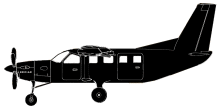
ASN Wikibase Occurrence # 309966
This information is added by users of ASN. Neither ASN nor the Flight Safety Foundation are responsible for the completeness or correctness of this information.
If you feel this information is incomplete or incorrect, you can submit corrected information.
| Date: | Monday 17 August 2015 |
| Time: | 07:30 LT |
| Type: |  Quest Kodiak 100 |
| Owner/operator: | Arrow West Aviation |
| Registration: | N771RT |
| MSN: | 100-0059 |
| Year of manufacture: | 2011 |
| Total airframe hrs: | 953 hours |
| Engine model: | Pratt & Whitney PT6A-34 |
| Fatalities: | Fatalities: 0 / Occupants: 6 |
| Aircraft damage: | Minor |
| Category: | Serious incident |
| Location: | Page, Arizona -
 United States of America United States of America
|
| Phase: | Take off |
| Nature: | Unknown |
| Departure airport: | Page, AZ |
| Moab-Canyonlands Field, UT (CNY/KCNY) | |
| Investigating agency: | NTSB |
| Confidence Rating: |
During the takeoff roll on the non-scheduled passenger flight, the pilot's seat slid back abruptly to the full-aft position. Because his right hand was positioned on the throttle for takeoff, the pilot inadvertently retarded the throttle to the idle position as the seat slid aft. The airplane began to veer off the runway and collided with a wire fence.
The seat was designed with two latches, one located on each of the right and left sides of the seat, which are lifted to enable the seat to move along the track. The seat track consisted of two metal rails that were affixed to the floor along the airplane's longitudinal axis. The rails had numerous circular receptacles where the seat stop would engage when the seat was locked into position. In order to move the seat, a handle on the latches would be raised upward, the seat stops would both raise, and the pilot could move the seat. The latch gives no positive indication (feel) when effectively raised or lowered. The before takeoff checklist contained in the pilot's operating handbook included the item, "seat locked and secure."
An examination of the pilot's seat revealed that both the left and the right aft locking foot caps were damaged. The locking foot caps comprise a four-pronged housing that encages the seat stop mechanisms. It is likely that the caps were damaged during maintenance and/or installation. Instead of completely removing the seat from the airplane, the technician likely pushed the seat all the way aft on the tracks. Investigators attempted to replicate the incident scenario and were successful only when applying an extreme side load or manipulating the latch. The lack of positive response in the latch of the stops being engaged in the tracks made it difficult to verify if the seat stops were positively engaged before the takeoff attempt. It is unknown if the damaged locking foot caps contributed to the incident.
Probable Cause: The pilot's inadvertent failure to engage the seat in the locked position before takeoff, which resulted in the seat sliding back during the takeoff roll and a subsequent loss of directional control. Contributing to the incident was the seat locking mechanism's design of limited feedback, which made it difficult to verify if the seat stops were positively engaged.
Accident investigation:
 |
|
Sources:
NTSB WPR15IA244
Location
Revision history:
| Date/time | Contributor | Updates |
|---|---|---|
| 01-Apr-2023 13:42 | ASN Update Bot | Added |
Corrections or additions? ... Edit this accident description
The Aviation Safety Network is an exclusive service provided by:


 ©2024 Flight Safety Foundation
©2024 Flight Safety Foundation